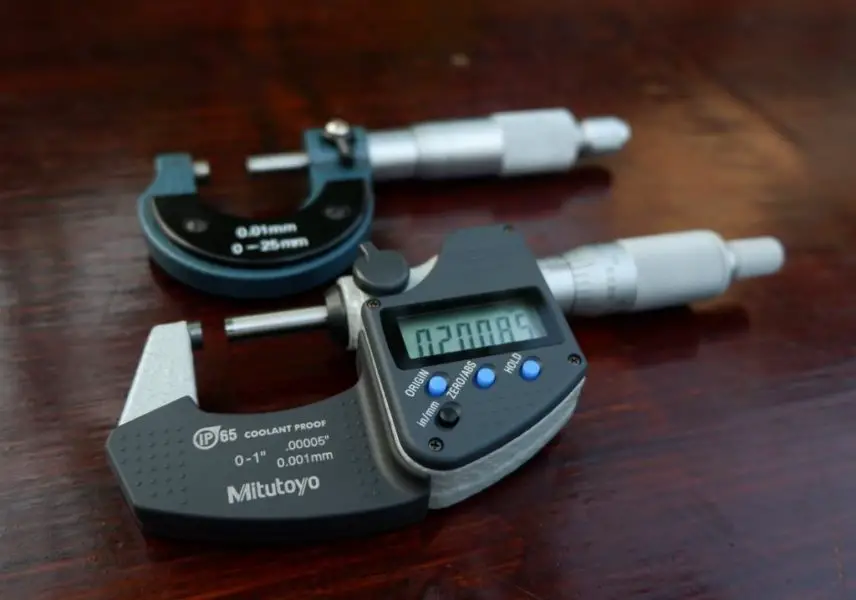Micrometers can be classified into mechanical dan digital models based on their working principle. These different working principles also affect the way these micrometers display the measurement reading. The mechanical model further varies based on how it shows the reading: dial, mechanical counter, and conventional micrometer.
If you are going to buy a new micrometer, perhaps this post can be helpful for you. We will present the advantages and disadvantages of each model in several points.
Mechanical Micrometer
Mechanical micrometers mean no electronic circuit that empowers these measuring tools. Therefore, it can be a dial micrometer, mechanical counter micrometer, vernier scale micrometer, and the general mechanical micrometer (without vernier scale). However, the most used are the general and vernier scale micrometers.
 The general model micrometer applies the working principle of the screw and nut to generate the magnification of the reading; therefore you can read down to 0.001″ resolution. Equipped with two major scales: sleeve scale (stationary) and thimble scale (rotating).
The general model micrometer applies the working principle of the screw and nut to generate the magnification of the reading; therefore you can read down to 0.001″ resolution. Equipped with two major scales: sleeve scale (stationary) and thimble scale (rotating).
Some models come with an additional vernier scale on the sleeve. This vernier scale gives the micrometer finer accuracy down to 0.0001″ resolution. For those who are still beginners, using this type of micrometer is very fun and appropriate to practice how to calculate the reading.
Advantages:
- Affordable. It has a relatively lower price compared to the digital micrometers.
- No battery. You could put it and use it anytime you want without worrying whether the battery power is enough or not. There will be no suddenly unable to use it when you are really needing it (during the job) like the digital mic does when it runs out of battery.
- Last for a longer time. You don’t need to worry that the electronic circuit breaks apart and the battery leaks.
- Can be used in a harsh environment. No need to worry to use it in an oily or magnetic field environment.
Disadvantages:
- Slower reading. If you’re not familiar with it, you may need a note to calculate the measurement.
- More chance of error. The angle of reading has to be straight into the center of the barrel, otherwise, parallax error could possibly happen.
- One unit reading only. The scale is only available in one unit measurement. In other words, it is either in metric (mm) or imperial (inch). You have to convert the result manually if you want to convert into another unit reading.
Digital Micrometer
A digital micrometer is a product of excellent technology that employs an electronic circuit to manipulate the capacitance into digital signals, and further, to be numbers displayed on the LCD screen. That said, you don’t need to make any calculations because the measurement result is quickly displayed on the LCD screen.
Even further, a digital micrometer provides a slot for a cable to transfer the data of measurement into another electronic device such as tablets or computers.
People buy a digital micrometer in the hope to get a fast, easy, and accurate reading. Therefore, when you are buying a new micrometer, the digital model should be one of your considerations.
Advantages:
- Fast Reading. As the measurement taken by the device, the reading is displayed.
- Lower Error. It eliminates human errors.
- Switch to Mechanical. Some digital micrometer models have the thimble and sleeve scale. In case the battery is running out of power, it’s still useful because you can switch to the conventional way.
- Easy conversion. Generally, a digital micrometer provides a conversion button to let you easily convert the reading to mm or inch.
- Zeroing made easy at any point. Unlike zeroing the mechanical model which has to rotate the sleeve barrel to align the index line to mark 0 of thimble scale, zeroing in a digital micrometer is very easy. You can zero it at any position you like simply by hitting the zero button.
- Transferrable Data. Your measurement data can be transferred, stored, and analyzed on other devices.
Disadvantages:
- Sensitive to the external environment. Dust and water are the enemies of a digital micrometer. They can damage the inside circuit of the digital micrometer. If you want to make sure the micrometer can resist dust and water, the micrometers should be IP-rated.
- Battery. When the battery is out of power, you have to buy a new one. It will be a problem when you need the battery immediately but you don’t have the battery backup.
- Expensive. In general, a digital micrometer costs about hundreds of dollars. However, it’s reasonable in regard to its excellent performance.
Conclusion
So, what is your favorite model? Each of them has different pros and cons. In our opinion, the mechanical model is an appropriate choice for occasional use. On the other hand, when speed is required, the digital micrometer model is excellent for that case. So, it totally depends on your application. By recognizing the benefits of each model, you have the idea of which one is suitable for you.

